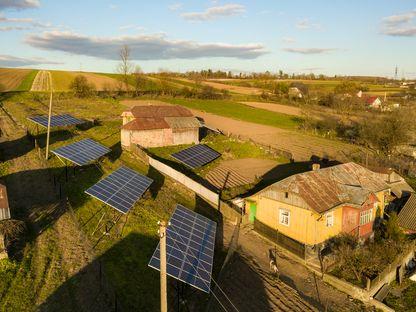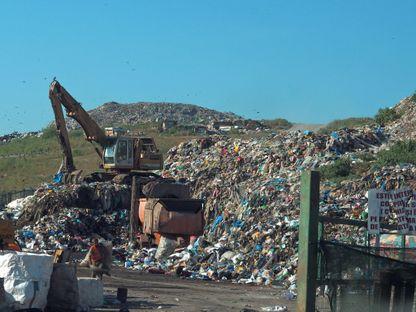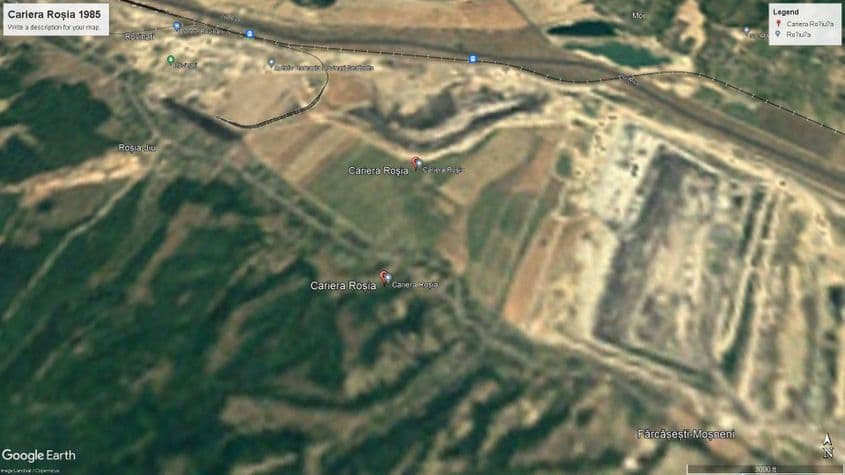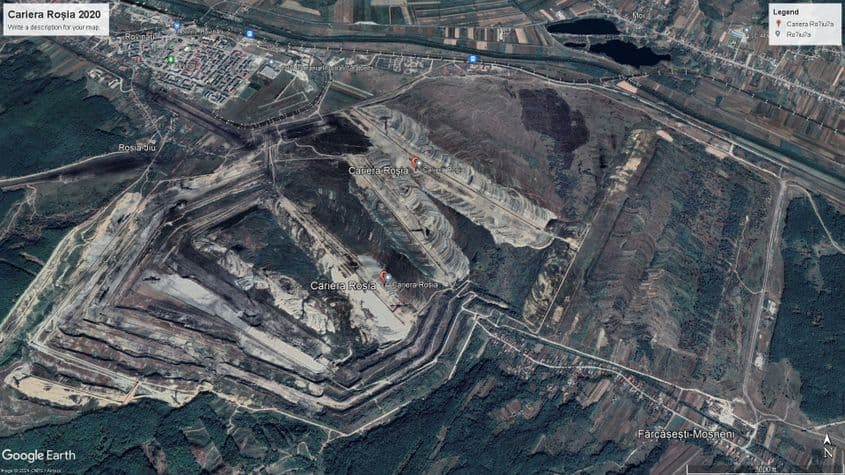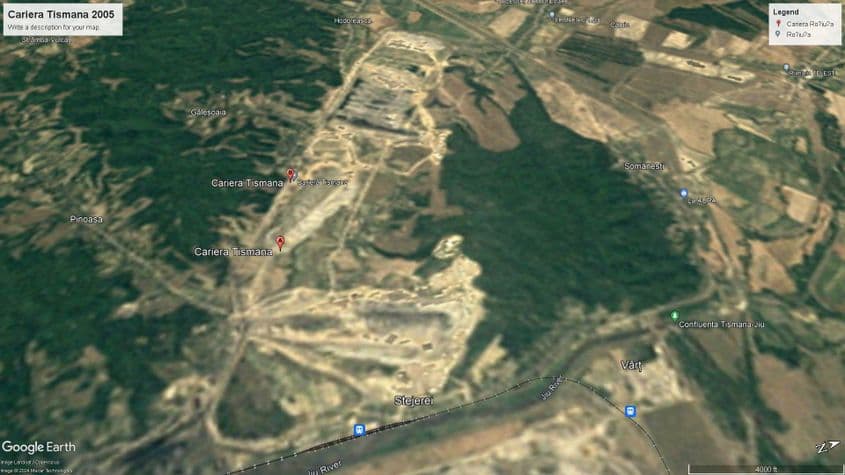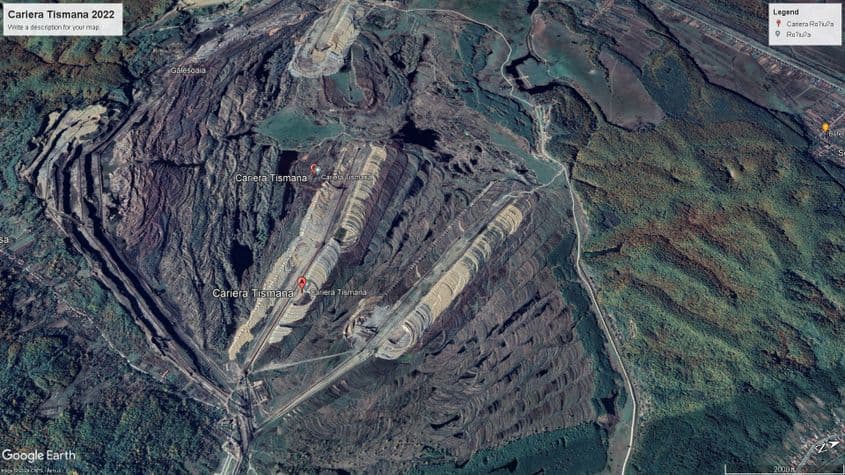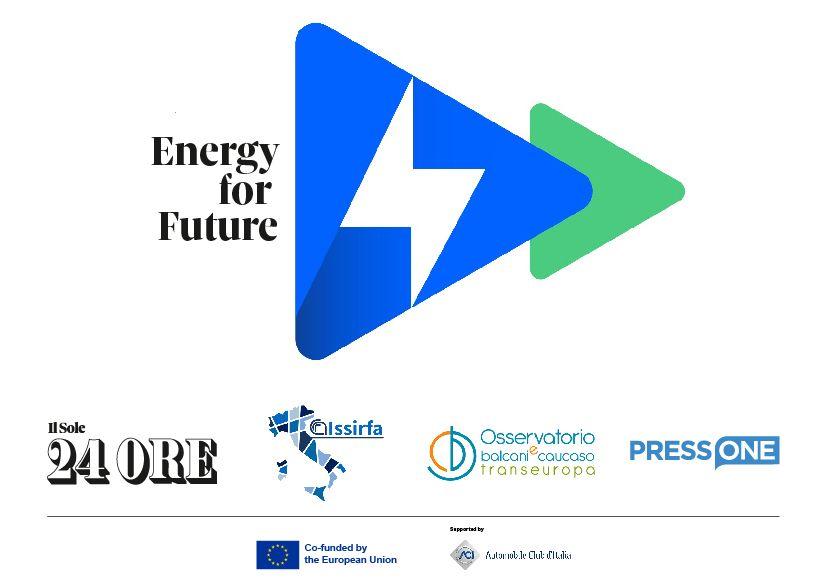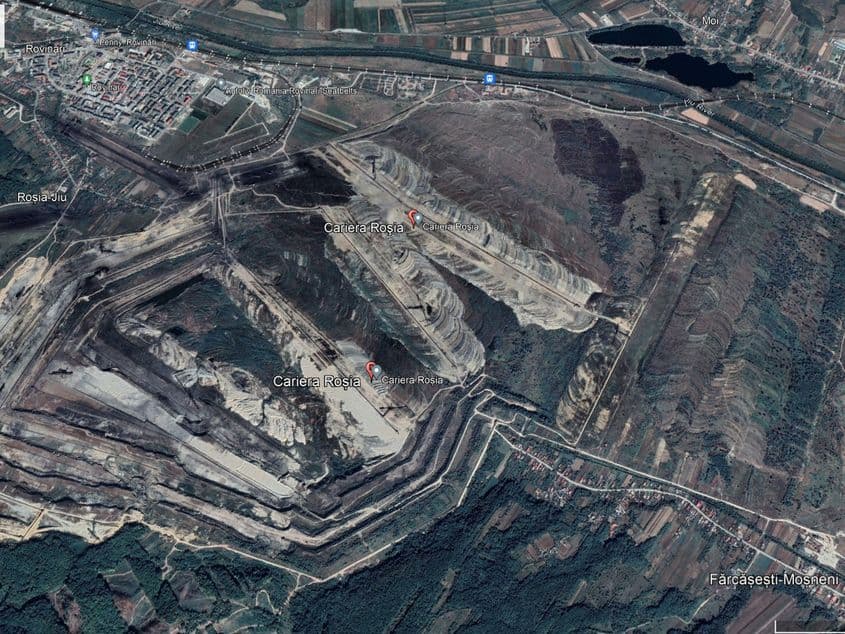
Evolution of the Roșia Quarry perimeter, 2020. Photo: Google Earth
12/03/2024
Coal Mining Expansion Leads to Deforestation: Over 470 Hectares of Forest Cut Down in Gorj, Romania
Over the past six years, more than 470 hectares of national forest land have been allocated by the government, without compensation, to the Oltenia Energy Complex (CEO) for the expansion or opening of new coal mines.
At the same time, Romania has committed itself, through the National Recovery and Resilience Plan (NRP), to phasing out lignite and hard coal energy production and to the gradual closure of mines by December 2032.
The government has also taken responsibility for restructuring the CEO, Romania's largest coal-fired power producer, by 2030, by closing or maintaining production capacity and investing in cleaner energy sources.
PressOne analysed the government decisions that transferred several hundred hectares from the forest reserve to increase the mining perimeter. We asked experts what this means in the current context, which the Romanian state has assumed, that of decarbonisation.
Zero responsibility for reforestation
"The main problem with granting land from the national forest fund for exploitation through a government decision rather than an environmental agreement is that there is no accountability for reforestation," explains Teofil Lata, coordinator of the "Mining and Thermal Power Plants" campaign run by Bankwatch Romania, an environmental NGO.
Moreover, he adds, government decisions no longer assess the environmental impact or quantify the losses from deforestation needed to expand coal mines.
According to the legislative portal of the Ministry of Justice, from 2018 to 2023, 13 government decisions have been issued for the definitive removal of various areas of land from the forestry fund, without compensation, to the CEO.
In some cases, two government decisions were issued on the same day. For example, in 2019, the government led at the time by Viorica Dăncilă approved, on 17 July, two government decisions to remove 81.0248 ha and 28.5663 ha respectively from the forest fund. The first area was for the continuation of mining works at the Tismana II quarry, and the second for the "commissioning of the final production capacity of 8,500 thousand tonnes of lignite/year at the Jilț Sud quarry.
Complexul Energetic Oltenia currently has, according to the organisation chart, five other mining units:
Mulți ne citesc, puțini ne susțin. Fără ajutorul tău, nu putem continua să scriem astfel de articole. Cu doar 5 euro pe lună ne poți ajuta mai mult decât crezi și poți face diferența chiar acum!
| Rovinari |
| Roșia-Peșteana |
| Jilț |
| Motru |
| Husnicioara (in Mehedinți) |
The not-so-green Romania. The state delays settlements for photovoltaic panels by 2 years
PressOne reviews the main dysfunctions in the production, consumption and distribution of energy from renewable sources, as revealed by discussions with consumers and data provided by official sources at the request of our editorial office.
Romania's waste crisis. After 17 years and billions of euros spent, the recycling rate remains the lowest in the EU
Romania needed nearly two decades to declare its integrated waste management systems operational. Even so, it remains the EU member state with the lowest recycling rate—just 12%, stagnant since 2010—according to a country report discussed by the European Commission in June 2025.
Most of the decisions taken by the executive concerned the expansion of Tismana I and II (Rovinari), which together form the largest CEO quarry and cover, according to a Bankwatch report, 1533 hectares, Rosia de Jiu (Rovinari), Rosita (Motru), Jilț South and North (Jilț) and Timișeni-Pinoasa (Rovinari), one of the newest quarries, opening in November 2023.
Amendments to the Forestry Code
According to the Forestry Code, it is forbidden to reduce the national forest fund. With a few exceptions. When it comes to the realisation of objectives of national interest and public utility, such as the extension of mining works, the reduction of the forest area is possible.
Un newsletter pentru cititori curioși și inteligenți.
Sunt curios
In May 2018, the Forestry Code was amended, and since then the definitive removal of land required for mining works is "carried out without compensation and approved by Government decision". This means that the person requesting such land will no longer exchange it for land with a similar surface area or pay for it.
Thus, on the agenda of the government meeting of 15 November 2018 appeared, among others, a government decision on "approving the definitive removal from the national forest fund, without compensation, by the Company Complexul Energetic Oltenia - S.A., of the land in the area of 110.1079 ha", for "the opening and commissioning of the Jilț Nord Quarry at a capacity of 4.5 million tons of lignite/year".
The Roșia quarry is the second largest quarry in Romania, with an area of over 1400 ha. This is what the quarry perimeter looked like in 1985, according to Google Earth images
Prior to 2018, the areas of forest land that were transferred from state ownership to CEO exploitation were provided for in an environmental agreement.
Forest vs coal
PressOne has compiled a timeline of government decisions to take areas of land out of the forest estate for mining purposes at CEO.
2018
- Decision No. 913 of 15 November 2018, area of 110.10 ha, for the opening and commissioning of the Jilț Nord Quarry at a capacity of 4.5 million tonnes/year of lignite;
2019
- Decision No 86 of 15 February 2019, area of 9.9991 ha, for the continuation of mining works in the Tismana I perimeter;
- Decision No 515 of 17 July 2019, area of 81.0248 ha, for the opening and commissioning of the Roșia de Jiu Quarry, with a capacity of 8.0 million tonnes/year of lignite;
- Decision No 516 of 17 July 2019, area of 28.5663 ha, for works to commission the final production capacity of 8,500 thousand tonnes/year of lignite at the Jilț Sud Quarry;
2020
- Decision No 537 of 9 July 2020, 2.6852 ha, for the opening and commissioning of the Rosita Quarry, with a capacity of 3,000,000 tonnes of lignite/year;
- Decision No 538 of 9 July 2020, area of 2.2652 ha, for commissioning works for the final production capacity of 8,500 thousand tonnes/year of lignite at the Jilț Sud Quarry;
- Decision No 536 of 9 July 2020, area of 9.4014 ha, for the opening and commissioning of the Rosita Quarry at a capacity of 3,000,000 tonnes of lignite/year;
- Decision No 927 of 28 October 2020, area of 9.0775 ha, for the continuation of mining works in the Tismana II perimeter;
2021
- Decision No 923/01.09.2021, area of 27.2219 ha, for the opening and commissioning of the Roșia de Jiu Quarry, with a capacity of 8.0 million tonnes/year;
- Decision No 496 of 28 April 2021, area of 17.0357 ha, for the continuation of mining works in the Tismana I perimeter;
2022
- Decision No 1.041 of 18 August 2022, area of 30.2676 ha, for works to maintain and develop capacity at the Tismana I quarry to 5,000,000 tonnes/year of lignite;
2023
- Decision no.13/11.01.2023, area of 106,3515 ha, for the opening and commissioning of the Timișeni-Pinoasa Quarry, with a capacity of 8.000.000 tons/year of lignite;
- Decision No 1165/23.11.2023, area of 43,6624 ha, for the opening and commissioning of the Roșia de Jiu quarry, with a capacity of 8,000,000 tonnes/year of lignite.
For all the above areas, the removal of the forestry background and the expansion of the mining quarries was done with the clearing of the existing forest vegetation. This is while coal is the raw material that releases the most carbon dioxide.
Environmental impact
Marcel Mîndrescu holds a PhD in geography from the Stefan cel Mare University in Suceava and was part of the presidential group that drafted the report on "Limiting climate change and its impacts: an integrated approach for Romania".
According to him, the transfer of land from forestry to the CEO is in contradiction with what the presidential report says, which encourages the limitation of mining and coal-based energy production.
From an environmental point of view, mining activity creates a wound to the territory by destroying certain natural components. And in the case of Gorj, where lignite, a surface coal, is mined in a quarry rather than in a mine, the destruction spreads over even larger areas.
"The vegetation cover, especially the forest cover, which plays a role in carbon sequestration, will recover with great difficulty, especially in the current situation, when we are facing climate change," says the doctor of geography.
In Gorj, explains the university professor, the forest is predominantly composed of deciduous forests, which are more vulnerable than coniferous forests.
"When we clear a lot of forest, the forest will also be affected outside the actual clearing perimeter. There will be a lot of dust because of mining, and if you go down that with deciduous forests, which have a large leaf cover on which dust can settle, not enough light will penetrate and the forest will be affected," says Marcel Mîndrescu.
The soil, adds Mîndrescu, is becoming very vulnerable because it is being destroyed both by the mining action, the constant shaking, and the creation of access roads and covering it with tailings.
As for the area of forestry land permanently taken out of state ownership and entrusted to the CEO for mining work, Professor Mîndrescu says it is not large, but the consequences extend beyond the 477 hectares.
"Imagine that you want, in an olive grove, to put a pit. The area you take for this is small, but the effects of the pit are felt over the whole area," says Marcel Mîndrescu, PhD in geography at Stefan cel Mare University in Suceava.
The Tismana quarry was opened in 1978. This is what the mining area looked like in 2005, according to Google Earth images
The first forests that emerged from logging in the 1980s do not look like natural forests even today
According to environmental experts, it's hard to balance what it means to permanently remove 477 hectares from the forest and the energy produced from the coal extracted from the quarries that have been extended over those hectares. But what is clear, explains Bankwatch's Teofil Lata, is that "even today, the first forests that followed the logging of the 1980s do not look like natural forest".
Laura Bouriaud, a professor at the Faculty of Forestry at Stefan cel Mare University in Suceava and part of the consortium of experts who worked on the new Forestry Code, agrees.
"We can't equate 100 hectares of lost forest, from where it is now installed, with even 200 hectares of forest made elsewhere. There is no equivalence for the simple reason that the forest I create elsewhere does not have the same resistance, the same resilience," explains Professor Bouriaud.
In addition, the removal of forests from the forest fund for mining shows which direction the Romanian state chooses to go, says Laura Bouriaud.
"The state decides what it privileges. Does it privilege forest cover or energy security and then privilege coal mining? In the end it is the state's choice. It's also true that if it's still a state business, the environmental impact has to be reduced, minimised and assessed. If it's a state business, that doesn't mean it's allowed to pollute," explains Laura Bouriaud, a professor at the Faculty of Forestry at Stefan cel Mare University in Suceava.
How much more energy does the CEO produce
According to Transelectrica data, in February 2024, electricity production from coal will amount to around 850 MW, which is around 12% of total energy. In comparison, hydro power amounts to over 1,700 MW, 27% of the total, followed by hydro and nuclear.
"Since the beginning of January, the percentage has dropped from 13-14% to somewhere around 11.5%. On average, we have seen this year, it has remained at 10%," explains BankWatch expert Teofil Lata.
According to him, despite the fact that coal production has increased, the share of coal in the national energy mix has decreased. In addition, lignite from underground in Romania, Teofil adds, is said to have a very low calorific value.
"This calorific value is also due to the fact that it is young coal. And this calorific value refers to how much coal has to be burned to produce the same amount of energy. In comparison, on a European level, it is a young and quite weak coal," says the Bankwatch expert.
According to the revised restructuring plan approved by the European Commission, Complexul Energetic Oltenia would have an installed capacity of 2,225 MW of electricity production in three of its thermal power plants: Rovinari 990 MW; Turceni 990 MW and Ișalnița 315 MW. An Economedia analysis shows, however, that CEO rarely produces more than 1,000 MW, the main reasons being environmental costs and the state of the installations.
"Coal used as fuel, although from own sources, generates a large amount of carbon dioxide, which implies additional costs for the purchase of CO2 certificates. The cost of CO2 certificates as a share of turnover was 45% in 2019 and 41% in 2018," the CEO's revised restructuring plan states.
For example, in 2019, all four CEO thermal power plants emitted more than 11 million tonnes of carbon dioxide emissions, for which €287 million was paid (€36 million CEO own funds and €251 million state aid).
Decarbonisation law
In 2022, Romania adopted decarbonisation legislation, which sets out the steps to eliminate coal from the country's total energy production, close and secure lignite and hard coal mines, restructure the CEO, and retrain the workforce in mono-industrial areas.
Thus, by the end of 2022, 660 MW of lignite-fired power generation capacity should have been taken out of operation by CEO, which the government postponed until June 2023.
"At the end of last year (no. 2022) we asked the European Commission for an extension of the operation of Rovinari 3 and Turceni 7 until 30 September 2023. Following the negotiations with the Commission and, obviously, in the current market conditions, where Romania is a net exporter of energy, practically since the beginning of the year, and with hydro energy in abundance, starting June 1 these groups will be withdrawn and put in conservation″, declared in June 2023, the Minister of Energy at the time, Virgil Popescu, to Profit News TV.
Next, by the end of 2025, the government must remove another 1,425 MW of lignite-based power generation capacity, and by the end of 2032 at the latest another 1,140 MW of lignite and hard coal-based generation capacity.
The future, gas and solar
Also part of the decarbonisation process are the investments in gas-fired power generation capacities foreseen in the restructuring plan of Complexul Energetic Oltenia. Two energy groups with a total capacity of 1,325 MW should be commissioned in the next two years: Ișalnița with 850 MW and Turceni with 475 MW.
To compensate for the remaining electricity needs after the closure of lignite-based generation capacities, several photovoltaic parks are to be commissioned.
"This is an alternative you can use at the quarries, because there is already a cable system in place to transport high-level electricity. There are already 6 or 8 projects to put photovoltaic panels on quarries, but unfortunately none of them are completed," says Teofil Lata, Bankwatch expert, an environmental NGO.
Last but not least, in 2023, more than 9,000 people were working at CEO, 40% of whom were over 50 years old, for whom the state needs to consider retraining programmes. But the expansion of coal mines is keeping the workforce locked into a polluting sector whose future is uncertain.
After the 2019 European Parliament elections, a fair transition mechanism has been created at EU level, including a fair transition fund, i.e. European funds for regions where the transition to climate neutrality will be most difficult. Romania is the third largest beneficiary after Poland and Germany and ahead of the Czech Republic and Bulgaria.
Romania has been allocated €2.14 billion, plus €360 million in co-financing from the government. The money would fund projects in six vulnerable counties in Romania, where the biggest polluters operate, where heavy industry will need to modernise from the ground up and where people trapped in polluting jobs need to be retrained. These are Dolj, Gorj, Galati, Hunedoara, Mures and Prahova.
But, as PressOne has already pointed out, "retraining has failed where miners have been retrained as barbers".
___
This article is published as part of the Energy4Future project, co-funded by the European Union. The European Union is not responsible for the information and opinions expressed in this project and article. Responsibility for the content lies entirely with PressOne.

Avem nevoie de ajutorul tău!
Mulți ne citesc, puțini ne susțin. Asta e realitatea. Dar jurnalismul independent și de serviciu public nu se face cu aer, nici cu încurajări, și mai ales nici cu bani de la partide, politicieni sau industriile care creează dependență. Se face, în primul rând, cu bani de la cititori, adică de cei care sunt informați corect, cu mari eforturi, de puținii jurnaliști corecți care au mai rămas în România.
De aceea, este vital pentru noi să fim susținuți de cititorii noștri.
Dacă ne susții cu o sumă mică pe lună sau prin redirecționarea a 3.5% din impozitul tău pe venit, noi vom putea să-ți oferim în continuare jurnalism independent, onest, care merge în profunzime, să ne continuăm lupta contra corupției, plagiatelor, dezinformării, poluării, să facem reportaje imersive despre România reală și să scriem despre oamenii care o transformă în bine. Să dăm zgomotul la o parte și să-ți arătăm ce merită cu adevărat știut din ce se întâmplă în jur.
Ne poți ajuta chiar acum. Orice sumă contează, dar faptul că devii și rămâi abonat PressOne face toată diferența. Poți folosi direct caseta de mai jos sau accesa pagina Susține pentru alte modalități în care ne poți sprijini.
Vrei să ne ajuți? Orice sumă contează.
Share this


